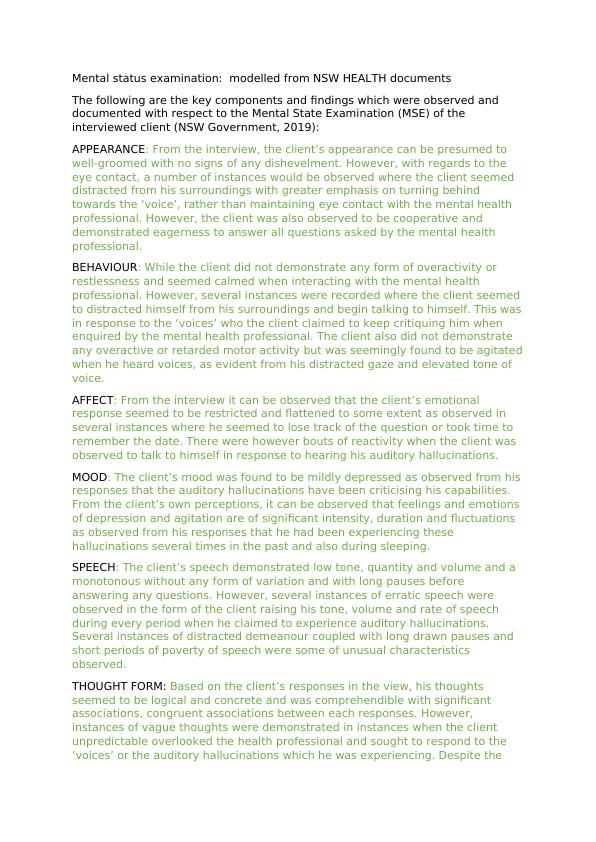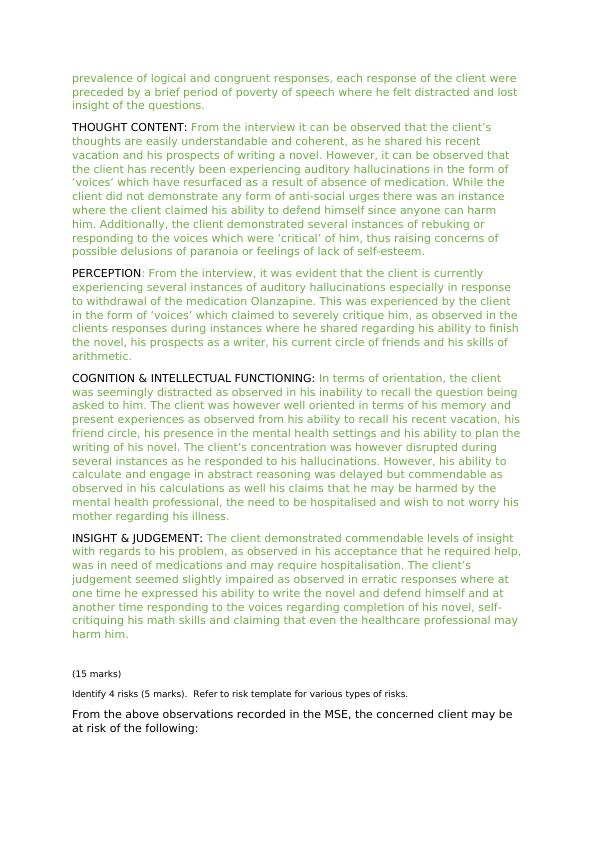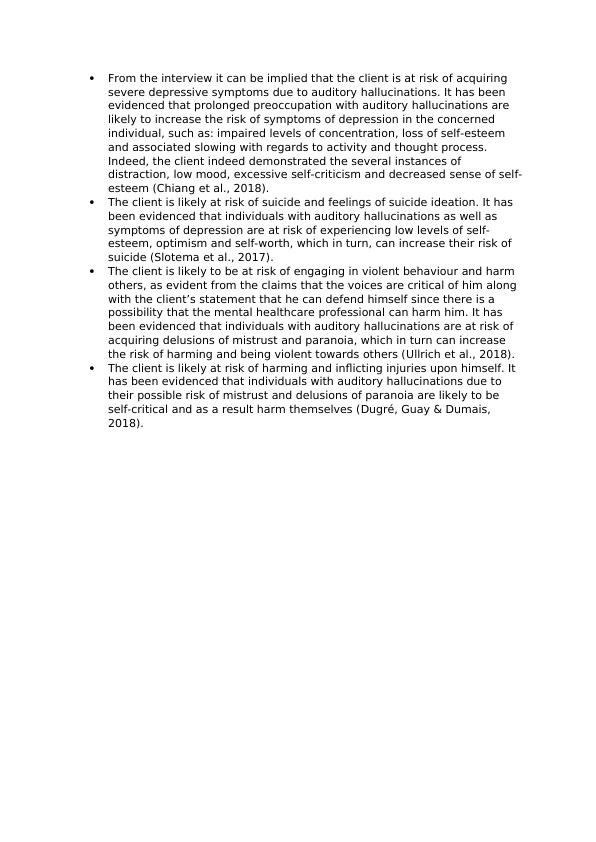Mental status Examination
Added on 2022-08-19
8 Pages3278 Words14 Views
Mental status examination: modelled from NSW HEALTH documents
The following are the key components and findings which were observed and
documented with respect to the Mental State Examination (MSE) of the
interviewed client (NSW Government, 2019):
APPEARANCE: From the interview, the client’s appearance can be presumed to
well-groomed with no signs of any dishevelment. However, with regards to the
eye contact, a number of instances would be observed where the client seemed
distracted from his surroundings with greater emphasis on turning behind
towards the ‘voice’, rather than maintaining eye contact with the mental health
professional. However, the client was also observed to be cooperative and
demonstrated eagerness to answer all questions asked by the mental health
professional.
BEHAVIOUR: While the client did not demonstrate any form of overactivity or
restlessness and seemed calmed when interacting with the mental health
professional. However, several instances were recorded where the client seemed
to distracted himself from his surroundings and begin talking to himself. This was
in response to the ‘voices’ who the client claimed to keep critiquing him when
enquired by the mental health professional. The client also did not demonstrate
any overactive or retarded motor activity but was seemingly found to be agitated
when he heard voices, as evident from his distracted gaze and elevated tone of
voice.
AFFECT: From the interview it can be observed that the client’s emotional
response seemed to be restricted and flattened to some extent as observed in
several instances where he seemed to lose track of the question or took time to
remember the date. There were however bouts of reactivity when the client was
observed to talk to himself in response to hearing his auditory hallucinations.
MOOD: The client’s mood was found to be mildly depressed as observed from his
responses that the auditory hallucinations have been criticising his capabilities.
From the client’s own perceptions, it can be observed that feelings and emotions
of depression and agitation are of significant intensity, duration and fluctuations
as observed from his responses that he had been experiencing these
hallucinations several times in the past and also during sleeping.
SPEECH: The client’s speech demonstrated low tone, quantity and volume and a
monotonous without any form of variation and with long pauses before
answering any questions. However, several instances of erratic speech were
observed in the form of the client raising his tone, volume and rate of speech
during every period when he claimed to experience auditory hallucinations.
Several instances of distracted demeanour coupled with long drawn pauses and
short periods of poverty of speech were some of unusual characteristics
observed.
THOUGHT FORM: Based on the client’s responses in the view, his thoughts
seemed to be logical and concrete and was comprehendible with significant
associations, congruent associations between each responses. However,
instances of vague thoughts were demonstrated in instances when the client
unpredictable overlooked the health professional and sought to respond to the
‘voices’ or the auditory hallucinations which he was experiencing. Despite the
The following are the key components and findings which were observed and
documented with respect to the Mental State Examination (MSE) of the
interviewed client (NSW Government, 2019):
APPEARANCE: From the interview, the client’s appearance can be presumed to
well-groomed with no signs of any dishevelment. However, with regards to the
eye contact, a number of instances would be observed where the client seemed
distracted from his surroundings with greater emphasis on turning behind
towards the ‘voice’, rather than maintaining eye contact with the mental health
professional. However, the client was also observed to be cooperative and
demonstrated eagerness to answer all questions asked by the mental health
professional.
BEHAVIOUR: While the client did not demonstrate any form of overactivity or
restlessness and seemed calmed when interacting with the mental health
professional. However, several instances were recorded where the client seemed
to distracted himself from his surroundings and begin talking to himself. This was
in response to the ‘voices’ who the client claimed to keep critiquing him when
enquired by the mental health professional. The client also did not demonstrate
any overactive or retarded motor activity but was seemingly found to be agitated
when he heard voices, as evident from his distracted gaze and elevated tone of
voice.
AFFECT: From the interview it can be observed that the client’s emotional
response seemed to be restricted and flattened to some extent as observed in
several instances where he seemed to lose track of the question or took time to
remember the date. There were however bouts of reactivity when the client was
observed to talk to himself in response to hearing his auditory hallucinations.
MOOD: The client’s mood was found to be mildly depressed as observed from his
responses that the auditory hallucinations have been criticising his capabilities.
From the client’s own perceptions, it can be observed that feelings and emotions
of depression and agitation are of significant intensity, duration and fluctuations
as observed from his responses that he had been experiencing these
hallucinations several times in the past and also during sleeping.
SPEECH: The client’s speech demonstrated low tone, quantity and volume and a
monotonous without any form of variation and with long pauses before
answering any questions. However, several instances of erratic speech were
observed in the form of the client raising his tone, volume and rate of speech
during every period when he claimed to experience auditory hallucinations.
Several instances of distracted demeanour coupled with long drawn pauses and
short periods of poverty of speech were some of unusual characteristics
observed.
THOUGHT FORM: Based on the client’s responses in the view, his thoughts
seemed to be logical and concrete and was comprehendible with significant
associations, congruent associations between each responses. However,
instances of vague thoughts were demonstrated in instances when the client
unpredictable overlooked the health professional and sought to respond to the
‘voices’ or the auditory hallucinations which he was experiencing. Despite the

prevalence of logical and congruent responses, each response of the client were
preceded by a brief period of poverty of speech where he felt distracted and lost
insight of the questions.
THOUGHT CONTENT: From the interview it can be observed that the client’s
thoughts are easily understandable and coherent, as he shared his recent
vacation and his prospects of writing a novel. However, it can be observed that
the client has recently been experiencing auditory hallucinations in the form of
‘voices’ which have resurfaced as a result of absence of medication. While the
client did not demonstrate any form of anti-social urges there was an instance
where the client claimed his ability to defend himself since anyone can harm
him. Additionally, the client demonstrated several instances of rebuking or
responding to the voices which were ‘critical’ of him, thus raising concerns of
possible delusions of paranoia or feelings of lack of self-esteem.
PERCEPTION: From the interview, it was evident that the client is currently
experiencing several instances of auditory hallucinations especially in response
to withdrawal of the medication Olanzapine. This was experienced by the client
in the form of ‘voices’ which claimed to severely critique him, as observed in the
clients responses during instances where he shared regarding his ability to finish
the novel, his prospects as a writer, his current circle of friends and his skills of
arithmetic.
COGNITION & INTELLECTUAL FUNCTIONING: In terms of orientation, the client
was seemingly distracted as observed in his inability to recall the question being
asked to him. The client was however well oriented in terms of his memory and
present experiences as observed from his ability to recall his recent vacation, his
friend circle, his presence in the mental health settings and his ability to plan the
writing of his novel. The client’s concentration was however disrupted during
several instances as he responded to his hallucinations. However, his ability to
calculate and engage in abstract reasoning was delayed but commendable as
observed in his calculations as well his claims that he may be harmed by the
mental health professional, the need to be hospitalised and wish to not worry his
mother regarding his illness.
INSIGHT & JUDGEMENT: The client demonstrated commendable levels of insight
with regards to his problem, as observed in his acceptance that he required help,
was in need of medications and may require hospitalisation. The client’s
judgement seemed slightly impaired as observed in erratic responses where at
one time he expressed his ability to write the novel and defend himself and at
another time responding to the voices regarding completion of his novel, self-
critiquing his math skills and claiming that even the healthcare professional may
harm him.
(15 marks)
Identify 4 risks (5 marks). Refer to risk template for various types of risks.
From the above observations recorded in the MSE, the concerned client may be
at risk of the following:
preceded by a brief period of poverty of speech where he felt distracted and lost
insight of the questions.
THOUGHT CONTENT: From the interview it can be observed that the client’s
thoughts are easily understandable and coherent, as he shared his recent
vacation and his prospects of writing a novel. However, it can be observed that
the client has recently been experiencing auditory hallucinations in the form of
‘voices’ which have resurfaced as a result of absence of medication. While the
client did not demonstrate any form of anti-social urges there was an instance
where the client claimed his ability to defend himself since anyone can harm
him. Additionally, the client demonstrated several instances of rebuking or
responding to the voices which were ‘critical’ of him, thus raising concerns of
possible delusions of paranoia or feelings of lack of self-esteem.
PERCEPTION: From the interview, it was evident that the client is currently
experiencing several instances of auditory hallucinations especially in response
to withdrawal of the medication Olanzapine. This was experienced by the client
in the form of ‘voices’ which claimed to severely critique him, as observed in the
clients responses during instances where he shared regarding his ability to finish
the novel, his prospects as a writer, his current circle of friends and his skills of
arithmetic.
COGNITION & INTELLECTUAL FUNCTIONING: In terms of orientation, the client
was seemingly distracted as observed in his inability to recall the question being
asked to him. The client was however well oriented in terms of his memory and
present experiences as observed from his ability to recall his recent vacation, his
friend circle, his presence in the mental health settings and his ability to plan the
writing of his novel. The client’s concentration was however disrupted during
several instances as he responded to his hallucinations. However, his ability to
calculate and engage in abstract reasoning was delayed but commendable as
observed in his calculations as well his claims that he may be harmed by the
mental health professional, the need to be hospitalised and wish to not worry his
mother regarding his illness.
INSIGHT & JUDGEMENT: The client demonstrated commendable levels of insight
with regards to his problem, as observed in his acceptance that he required help,
was in need of medications and may require hospitalisation. The client’s
judgement seemed slightly impaired as observed in erratic responses where at
one time he expressed his ability to write the novel and defend himself and at
another time responding to the voices regarding completion of his novel, self-
critiquing his math skills and claiming that even the healthcare professional may
harm him.
(15 marks)
Identify 4 risks (5 marks). Refer to risk template for various types of risks.
From the above observations recorded in the MSE, the concerned client may be
at risk of the following:

From the interview it can be implied that the client is at risk of acquiring
severe depressive symptoms due to auditory hallucinations. It has been
evidenced that prolonged preoccupation with auditory hallucinations are
likely to increase the risk of symptoms of depression in the concerned
individual, such as: impaired levels of concentration, loss of self-esteem
and associated slowing with regards to activity and thought process.
Indeed, the client indeed demonstrated the several instances of
distraction, low mood, excessive self-criticism and decreased sense of self-
esteem (Chiang et al., 2018).
The client is likely at risk of suicide and feelings of suicide ideation. It has
been evidenced that individuals with auditory hallucinations as well as
symptoms of depression are at risk of experiencing low levels of self-
esteem, optimism and self-worth, which in turn, can increase their risk of
suicide (Slotema et al., 2017).
The client is likely to be at risk of engaging in violent behaviour and harm
others, as evident from the claims that the voices are critical of him along
with the client’s statement that he can defend himself since there is a
possibility that the mental healthcare professional can harm him. It has
been evidenced that individuals with auditory hallucinations are at risk of
acquiring delusions of mistrust and paranoia, which in turn can increase
the risk of harming and being violent towards others (Ullrich et al., 2018).
The client is likely at risk of harming and inflicting injuries upon himself. It
has been evidenced that individuals with auditory hallucinations due to
their possible risk of mistrust and delusions of paranoia are likely to be
self-critical and as a result harm themselves (Dugré, Guay & Dumais,
2018).
severe depressive symptoms due to auditory hallucinations. It has been
evidenced that prolonged preoccupation with auditory hallucinations are
likely to increase the risk of symptoms of depression in the concerned
individual, such as: impaired levels of concentration, loss of self-esteem
and associated slowing with regards to activity and thought process.
Indeed, the client indeed demonstrated the several instances of
distraction, low mood, excessive self-criticism and decreased sense of self-
esteem (Chiang et al., 2018).
The client is likely at risk of suicide and feelings of suicide ideation. It has
been evidenced that individuals with auditory hallucinations as well as
symptoms of depression are at risk of experiencing low levels of self-
esteem, optimism and self-worth, which in turn, can increase their risk of
suicide (Slotema et al., 2017).
The client is likely to be at risk of engaging in violent behaviour and harm
others, as evident from the claims that the voices are critical of him along
with the client’s statement that he can defend himself since there is a
possibility that the mental healthcare professional can harm him. It has
been evidenced that individuals with auditory hallucinations are at risk of
acquiring delusions of mistrust and paranoia, which in turn can increase
the risk of harming and being violent towards others (Ullrich et al., 2018).
The client is likely at risk of harming and inflicting injuries upon himself. It
has been evidenced that individuals with auditory hallucinations due to
their possible risk of mistrust and delusions of paranoia are likely to be
self-critical and as a result harm themselves (Dugré, Guay & Dumais,
2018).

End of preview
Want to access all the pages? Upload your documents or become a member.
Related Documents
Mental Status Examination and Care Plan for a Patient with Auditory Hallucinationslg...
|6
|1991
|423
Mental Health Assessmentlg...
|9
|2498
|284
Mental Health and Wellbeing: Assessment, Risk Factors, Care Plan, and Positive/Negative Interactionlg...
|14
|3075
|238
Mental Health: Assessment, Risk Factors, and Care Planlg...
|14
|2876
|284
The Mental State Assessmentlg...
|9
|2208
|21
Psychosis a Case Study And Question Answerlg...
|8
|2069
|51
